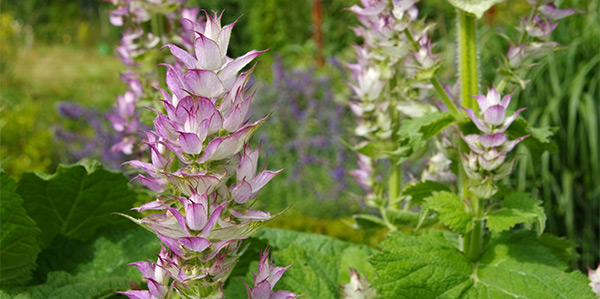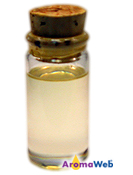Clary Sage Essential Oil
Salvia sclarea

Description
Clary Sage Essential Oil is one of the first essential oils that I tried for combating stress, and I quickly fell in love with its ability to ease stress and calm frazzled nerves. Containing approximately 60-70% Linalyl Acetate, Clary Sage Essential Oil is likely the essential oil that is highest in this calming ester. linalyl acetate is also present, at lower levels, in several other essential oils including but not limited to Lavender, Petitgrain, Bergamot and Bergamot Mint. Clary Sage Essential Oil also contains approximately 10-15% linalol.

Probably the most intriguing constituent present within the oil is sclareol, a diterpene. To my understanding, diterpenes are not usually present within essential oils due to their molecular weight as they tend to be too heavy for distillation. The absolute (which I'm not profiling here) tends to have significantly more sclareol. Due to its sclareol content, there has been some debate about the estrogenic action of Clary Sage Essential Oil. Robert Tisserand writes at length about this concern: Is Clary Sage Oil Estrogenic?
Clary Sage Essential Oil is widely used in a number of topical, respiratory, digestive, emotional and feminine issues. Please refer to the Uses section below.
Clary Sage Essential Oil is considered an aphrodisiac by some. Within chakra work, Clary Sage Essential Oil is said to be helpful in balancing and supporting the Sacral Chakra and the Third Eye Chakra.
Aromatically, Clary Sage Essential Oil has a distinctive herbaceous, earthy, slightly floral scent. In my aromatic beginnings, I found the aroma of the essential oil a little surprising at first, but I quickly began to find it soothing and pleasurable. Not everyone grows to like the scent of Clary Sage Essential Oil. Blending it with other essential oils can go a long way towards camouflaging the aroma while still taking advantage of the wonders of this helpful oil.
Clary Sage Essential Oil blends well with essential oils in the citrus, floral, herbaceous and wood families. I find that it blends particular well with the following essential oils: bergamot, lime, lavender, roman chamomile, sandalwood, cedarwood, patchouli and rose.
Clary Sage Essential Oil Benefits and Uses
- Acne
- Boils
- Skin Inflammation
- Hair Loss
- Dandruff
- Dry Or Mature Skin
- Muscular Aches And Pains
- Whooping Cough
- Asthma Attacks
- Eases Menstrual Pain
- Regulation Of Menstrual Flow
- Flatulence
- Intestinal Cramping
- Colic
- Stress
- Nerves
- High Blood Pressure
- Amenorrhea
- Asthma
- Coughing
- Dysmenorrhea
- Exhaustion
- Labor Pains
- Sore Throat
Reading Purchon and Cantele's full profile for Clary Sage Essential Oil is recommended.
Sources: Neryls Purchon and Lora Cantele, Complete Aromatherapy & Essential Oils Handbook for Everyday Wellness (Toronto ON: Robert Rose, 2014), 50. Julia Lawless, The Illustrated Encyclopedia of Essential Oils (Rockport, MA: Element Books, 1995), 62-67.
Botanical Name
Plant Family
Common Method of Extraction
Steam Distilled
Plant Part Typically Used
Color
Pale Yellow
Consistency
Thin to Medium
Perfumery Note
Middle
Strength of Initial Aroma
Medium - Strong
Aromatic Description
Clary Sage Essential Oil smells earthy, herbaceous, floral and slightly fruity.
Major Constituents
- Linalyl Acetate
- Linalool
- a-Terpineol
- Germacrene D
- B-Caryophyllene
Tisserand and Young indicate that Sclareol is present in the steam distilled oil (and much higher in the absolute).
See Essential Oil Safety for a more complete list of typical constituents.
Source: Private Communication: Fakhry, 2002. Source cited in Robert Tisserand and Rodney Young, Essential Oil Safety (Second Edition. United Kingdom: Churchill Livingstone Elsevier, 2014), 253.
Clary Sage Essential Oil Safety Information
Tisserand and Young do not indicate any known hazards for steam distilled Clary Sage Oil but recommend a dermal maximum of 0.25% for Clary Sage Absolute. Reading Tisserand and Young's full profile is recommended. [Robert Tisserand and Rodney Young, Essential Oil Safety (Second Edition. United Kingdom: Churchill Livingstone Elsevier, 2014), 253.]
Purchon and Cantele indicate that there is a moderate risk of sensitization in some individuals. [Neryls Purchon and Lora Cantele, Complete Aromatherapy & Essential Oils Handbook for Everyday Wellness (Toronto ON: Robert Rose, 2014), 50.]
Numerous sources recommend avoiding Clary Sage Oil while drinking alcohol and while driving due to the oil's potential narcotic effect. [Julia Lawless, The Illustrated Encyclopedia of Essential Oils (Rockport, MA: Element Books, 1995), 213.]
Various sources state that the sclareol content contained within Clary Sage may induce an "estrogen-like action." For that reason, it would be wise for those with breast cancer, at high risk for breast cancer or that need to carefully regulate their estrogen levels avoid Clary Sage. Having said that, Aromatherapy Science by Maria Lis-Balchin states the following: "This essential oil is quoted widely in the aromatherapy literature as being estrogenic, but clear scientific evidence has not been forthcoming. However, due to the spasmolytic effect on the uterus in vitro, caution should be used in pregnancy and parturition." [Maria Lis-Balchin, Aromatherapy Science: A Guide for Healthcare Professionals (United Kingdom: Pharmaceutical Press, 2006), 169.]
General Safety Information
Do not take any oils internally and do not apply undiluted essential oils, absolutes, CO2s or other concentrated essences onto the skin without advanced essential oil knowledge or consultation from a qualified aromatherapy practitioner. For general dilution information, read AromaWeb's Guide to Diluting Essential Oils. If you are pregnant, epileptic, have liver damage, have cancer, or have any other medical problem, use oils only under the proper guidance of a qualified aromatherapy practitioner. Use extreme caution when using oils with children and be sure to first read the recommended dilution ratios for children. Consult a qualified aromatherapy practitioner before using oils with children, the elderly, if you have medical issues or are taking medications. Before using this or any essential oil, carefully read AromaWeb's Essential Oil Safety Information page. For in-depth information on oil safety issues, read Essential Oil Safety by Robert Tisserand and Rodney Young.
Shelf Life
Important Information About the Profiles
The essential oil information provided on AromaWeb is intended for basic educational purposes only. The references to safety information, test results, constituents and percentages is generalized information. Essential oils can vary greatly in composition. The data is not necessary complete and is not guaranteed to be accurate. The essential oil photos are intended to represent the typical and approximate color of each essential oil. However, essential oil composition and color can vary based on harvesting, distillation, age of the essential oil and other factors. Profiles for several CO2 Extracts and absolutes are included within the directory, and are denoted as such.
